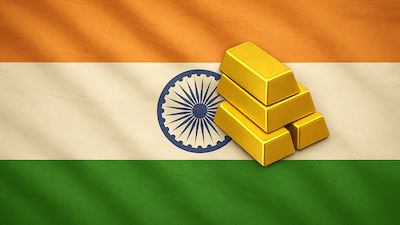(Mike Maharrey, Money Metals News Service) High prices continue to put a drag on Indian gold jewelry sales even as investment buying surges.
India ranks as the second-largest gold market globally behind China.
Gold extended its gains in July, remaining the top Indian investment class with a 28 percent gain on the year.
According to the World Gold Council, the re-emergence of trade risks helped push gold prices higher during the first two weeks in July, with the yellow metal gaining about 1 percent in rupee terms.
High Prices, Seasonal Weakness Create Headwinds for Gold Jewelry Demand
Higher prices have put a damper on the Indian gold jewelry market. Seasonal weakness in June and early July, following the end of the wedding season, put a further drag on jewelry sales.
Indian consumers seem to be opting for smaller or lower-karat pieces. There has also been a surge in demand for less expensive silver jewelry.
According to the World Gold Council, anecdotal evidence suggests that Indians are monetizing their gold jewelry by exchanging old pieces for new, liquidating it altogether, or using it as collateral for loans. Some companies reported that a gold exchange was involved in as many as 40 percent of their sales.
Even with the slowdown in sales, Indian jewelry dealers are reaping the benefits of higher prices. Listed jewelers posted double-digit revenue growth in the second quarter, despite flat or lower volumes.
Investment Demand Maintains Momentum
As the gold price has soared, there has been a pronounced shift toward investment gold buying in India. The World Gold Council reports a growing preference for gold bars, coins, and plain gold chains. Demand has been particularly strong for small coins weighing less than 10 grams.
Indians have increasingly been using ETFs to gain exposure to gold. India-based gold funds reported gold inflows of 2 tonnes in June. Indian ETFs have added 9 tonnes of gold since the beginning of the year, driving gold holdings to 66.7 tonnes.
Cumulative assets under management (AUM) in Indian gold funds rose to ₹648 billion, an 88 percent year-on-year increase.
According to the World Gold Council, the momentum continued through the first two weeks of July, with “healthy inflows.”
There were 280,000 new accounts opened in June, a 27 percent month-on-month increase. There are now 7.65 million gold ETF accounts in India. According to the WGC, “The expanding investor base underscores the growing strategic role of gold in Indian portfolios.”
A gold ETF is backed by a trust company that holds metal owned and stored by the trust. In most cases, investing in an ETF does not entitle you to any amount of physical gold. You own a share of the ETF, not gold itself. ETFs are a convenient way for investors to play the gold market, but owning ETF shares is not the same as holding physical gold.
With higher prices putting a damper on gold jewelry demand, gold imports fell sharply in June. Imports were down about 26 percent year-on-year. Based on customs reports, the World Gold Council estimates India imported between 19 and 24 tonnes of gold last month.
India’s Love Affair With Gold
Indians have a longstanding love affair with gold.
The yellow metal is deeply interwoven into the country’s marriage ceremonies, along with its religious and cultural rituals. Festival seasons typically boost gold demand.
Indians have long valued the yellow metal as a store of wealth, especially in poorer rural regions. Around two-thirds of India’s gold demand comes from beyond the urban centers, where large numbers of people operate outside the tax system. Many Indians use gold jewelry not only as an adornment but as a way to preserve wealth.
In the West, gold is generally viewed as a luxury item. Not in India. Even poor Indians buy gold.
According to a 2018 ICE360 survey, one in every two households in India had purchased gold within the last five years. Overall, 87 percent of Indian households own some gold. Even households at the lowest income levels in India hold some of the yellow metal. According to the survey, more than 75 percent of families in the bottom 10 percent of income managed to buy some gold.
The yellow metal was a lifeline for Indians buffeted by the economic storm caused by the government’s response to COVID-19. After the Indian government locked down the country, banks tightened credit to mitigate the default risk. Unable to secure traditional loans, Indians used gold to secure financing. As Indians endured a second wave of lockdowns, many Indians resorted to selling gold outright to make ends meet.
Mike Maharrey is a journalist and market analyst for Money Metals with over a decade of experience in precious metals. He holds a BS in accounting from the University of Kentucky and a BA in journalism from the University of South Florida.

